Author: Francis Brenders
Rome was a populous city that ruled over an extensive empire. As an administrative centre and centre of power the city depended almost completely on external imports to meet its basic needs. Corn as main staple played a primary role, but other products such as wine, oil, garum, building materials and even animals for the games had to be imported as well. Initially the necessary stock was derived from the immediate hinterland of the city, but the more the empire grew the more these necessary goods were sought in the newly-occupied provinces. This initiated imports from Italy, Sicily, Sardinia, Spain, Gaul and finally Northern Africa. Egypt with its rich grain crops and fertile soil was of utmost importance.[1]
The majority of importation took place by sea. Until the beginning of the first century B.C. most ships arrived at Puteoli where it was easier to find harbours given the nature of the coast. Once unloaded in Puteoli, all these wares had to be transported to Rome over land. Yet transportation by road was always a costly and painful enterprise, so they began to ship goods directly to Ostia, where the mouth of the Tiber gave an excellent opportunity to develop a harbour. Even when the goods were safely unloaded at Ostia, the transport to Rome remained a problem. The Tiber between Ostia and Rome has many twists and turns. This portion of the river is also rather rapid, making it impossible for larger merchantmen to go upstream to the capital.
Dionysius of Halicarnassus described this situation at the end of the first century B.C. as follows:[2] "For the Tiber broadens greatly where it unites with the sea and forms great bays equal to those of the best seaports; and, most wonderful of all, its mouth is not blocked by sandbanks piled up by the sea, as happens in the case of many even of the large rivers, nor does it - by wandering this way and that through fens and marshes - spend itself before its stream unites with the sea, but it is everywhere navigable and discharges itself through its one genuine mouth, repelling the surge that comes from the main, notwithstanding the frequency and violence of the west wind on that coast. Accordingly, oared ships - however large - and merchantmen up to three thousand (bushel)[3] burden enter at the mouth of the river and are rowed and towed up to Rome, while those of a larger size ride at anchor off the mouth, where they are unloaded and loaded again by river boats."
A slightly different story is told by Strabo, who described the same location at the beginning of the first century A.D.:[4] "The seaboard cities belonging to the Latii are, first, Ostia. It is harbourless on account of the silting up which is caused by the Tiber, since the Tiber is fed by numerous streams. Now although it is with peril that the merchant-ships anchor far out in the surge, still, the prospect of gain prevails; and in fact the good supply of the tenders which receive the cargoes and bring back cargoes in exchange makes it possible for the ships to sail away quickly before they touch the river, or else, after being partly relieved of their cargoes, they sail into the Tiber and run inland as far as Rome, one hundred and ninety stadia."
These texts sketch the situation as it was before the harbour of Claudius was constructed. With the development of this harbour, which was finished by Nero, the problems should have been mostly resolved, but apparently the practice of anchoring in the open sea continued. Indeed, the harbour was enormous but, since the navigation season in antiquity was restricted to only seven months and the necessary stocks could be imported only during these seven months, the harbour was always bustling with activity and we may assume that many crafts still had to anchor in open sea. We know about a storm in the year 62 A.D. which destroyed 200 ships in the harbour of Claudius and a fire that destroyed another 100 ships that were ready to make their way up the Tiber.[5] This situation was exacerbated by the practice of merchantmen to navigate in convoy for safety, thus they usually reach harbour in large groups. Thus the ships would have to wait a long time before they were unloaded. We hear, for instance, about a grain ship that arrived at Ostia on a June 30 and was only handled on the 12th of July.[6] When we consider all of this information together, we can make some interesting observations.
In the texts of Dionysius of Halicarnassus and Strabo there are a few striking remarks. It was impossible for big merchantmen to navigate the Tiber upstream. Small ships had this capability, but they could do it hardly on their own. They had to be rowed or towed. It is of great importance that Dionysius gives us the maximum tonnage of the vessels that could navigate upstream. He talks about a maximum of 3.000 (unities) without specifying what kind of unit he refers to. Probably this unit is the amphora, which is approximately 26 kg.[7] This means that ships with a maximum of 78 tons could reach Rome. These smaller ships were apparently part of the standard equipment of the harbour since they unloaded goods from the larger vessels. These small ships brought the goods either to the warehouses of Ostia or to Rome. Moreover, these small vessels and their owners probably had a monopoly in the handling of freight as can be deduced from the papyrus in which we are told how a big merchantmen had to wait for his turn to be unloaded. The type of ship that was used to do these transports was called lenunculus. It was the task of the lenuncularii to handle the merchantmen, probably with the assistance of the saccarii, the dock-workers.
Against the background of the preceding remarks there is a lot to learn from the mosaic in statio 25 of the Piazzale delle Corporazioni.[8] The accurate details of the smaller ship make us even think that this was an office of the lenuncularii.
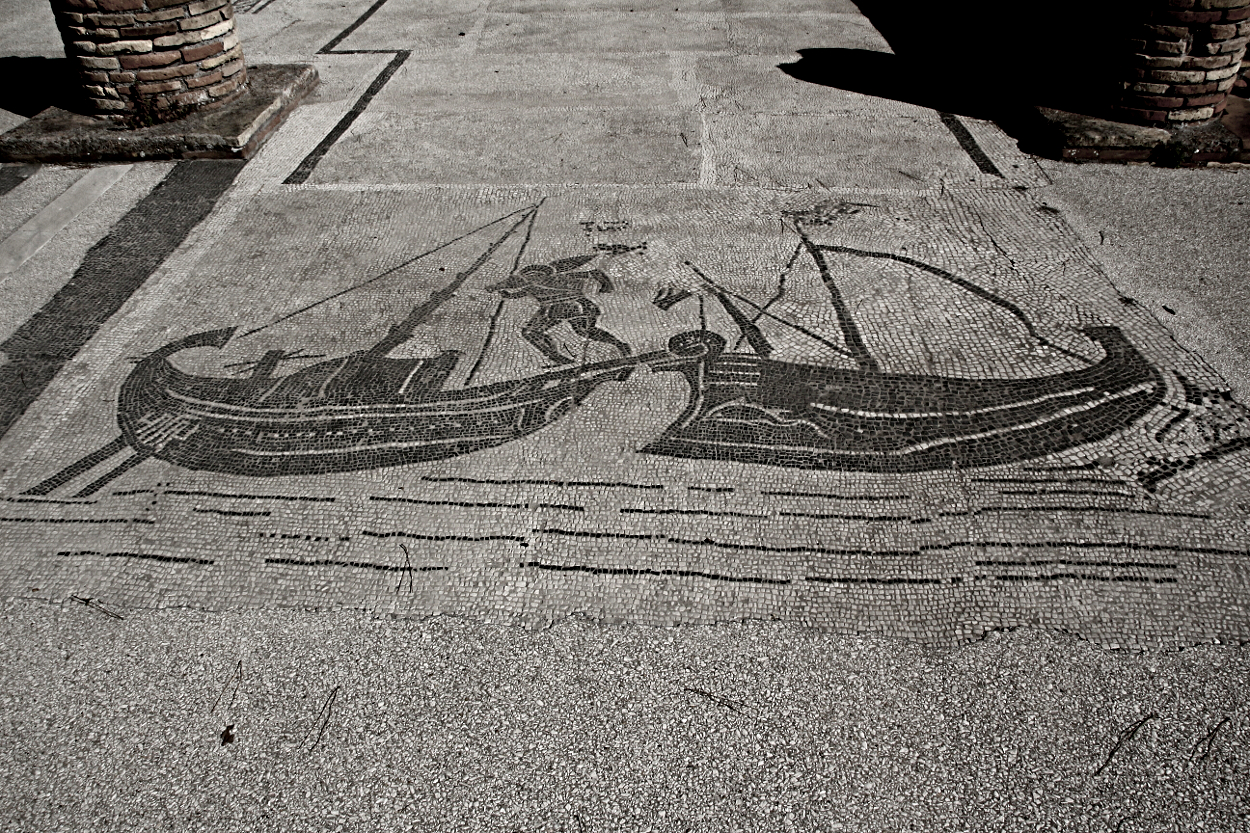
Fig. 1. Mosaic of statio 25.
We see two ships with their stems turned to each other, anchored in open sea. The open sea is suggested by the horizontal lines. Also the lighthouse which is usually represented in other mosaics is omitted, whence the suggestion of the open sea is affirmed. On the right side is a merchantman, at the left we see the lenunculus. Both ships are joined by a gangplank on which a dock-worker carries an amphora from the freighter to his lenunculus.
The first thing that catches the eye is the different scale in the representation of the ships. The merchantman, on the right, is made as small as the lenunculus, so it appears that more importance was given to the smaller boat. Moreover, the freighter is represented in a general and schematic way. It was heavily damaged by restorations which were executed even in antiquity, but notably without taking great care of the kind to recreate an accurate representation. The hull of the merchant ship is wide and spacious at the front and slimmer at the stern. The stern is characterized by the upward curve and the rudders that, due to the clumsy restoration, are hardly recognizable. The bow is concave with a protruding point above and beneath the water line that functioned as a breakwater. The ship has two masts. The main mast is stepped forward amidships with a slight forward slanting. It is secured in place by two lines from the stem and the bow. The smaller mast is placed on the stem. It has a forward rake and on top we still can see some remains of the yard with the furled sail. Unfortunately, this detail was also damaged during the repair of the mosaic and has almost completely disappeared. The purpose of this sail was rather an aid in steering the ship than an additional steering device.[9] The presence of two masts means that this ship was a larger merchantman with a large tonnage and that it was therefore impossible to navigate the Tiber upstream. Only large seagoing ships were equipped with a supplementary foresail.
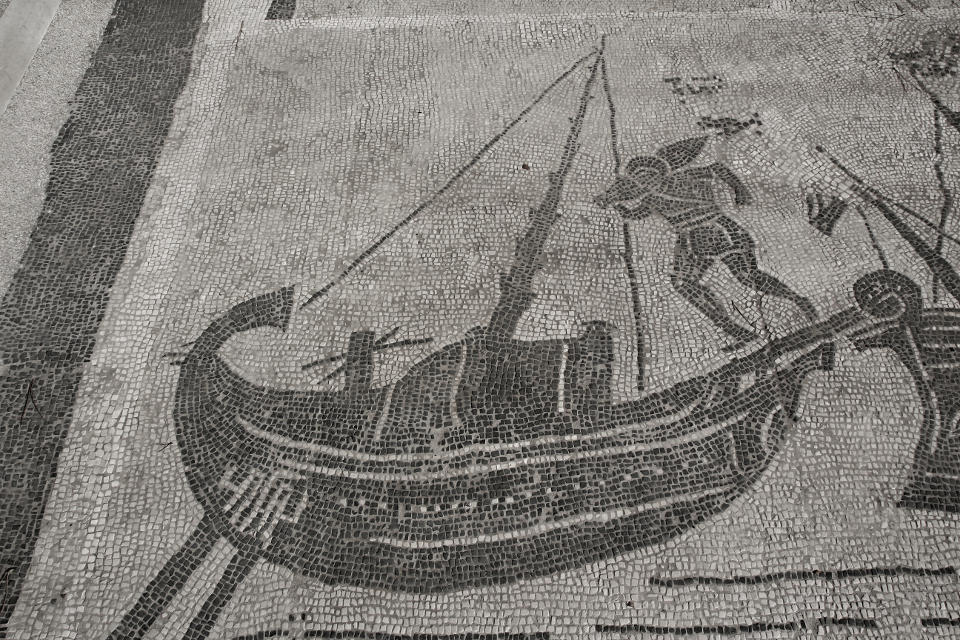
Fig. 2. Piazzale delle Corporazioni. Statio 25. Lenunculus.
The lenunculus is represented in more detail. The rounded hull is shaped like a spoon. The back part of the hull is clearly wider and heavier than the foredeck. The bow has a protruding stempost which supports the gangplank that is set between both ships. The stern shows an upward scroll that recalls the papyriform Egyptian ships. At the stern two steering oars are depicted. The mast is placed almost midship with a slight forward inclination. It is equipped with cleats that allowed the skipper to climb in the top of the mast to adjust the sail. The planks of the hull are rendered in great detail using lines of white tesserae. An interesting and intriguing feature is the horizontal row of white dots that runs over the middle of the hull. Friedman explains this as the representation of the nails with which a plank was attached to the frames of the ship.[10] But since we can't find this kind of detail on other ancient images of ships, and the layout of nails seems of little relevance, another explanation must be sought, namely through an analysis of ship construction.
Shipbuilders in antiquity started the construction of a ship by first assembling the hull.[11] This was done by joining planks horizontally starting from a keel. The planks were held together with clamps and tenons. Once the hull was more or less formed this way the ship was reinforced with internal frames. In ships that had to carry an extra charge it was possible that an extra transverse beam was added. These beams projected at the left and right out of the hull and were kept in place by an additional plank or slat. We can see this technique on many representations. The ships depicted on a relief from the Torlonia collection are an excellent example of this. Here we see two ships in the harbour of Ostia. Out of their flanks come the protruding ends of these transverse beams held on their place by another plank above them. Is it possible that we may interpret the dotted line over the lenunculus in the mosaic as a similar construction and may we explain the white lines above and under this dotted line as a separate plank that functioned as reinforcement of these transverse beams? If we accept this explanation, we can also admit the possibility of the construction of a deck which expanded the loading capacity of the ship and also created the condition to organise a hold.
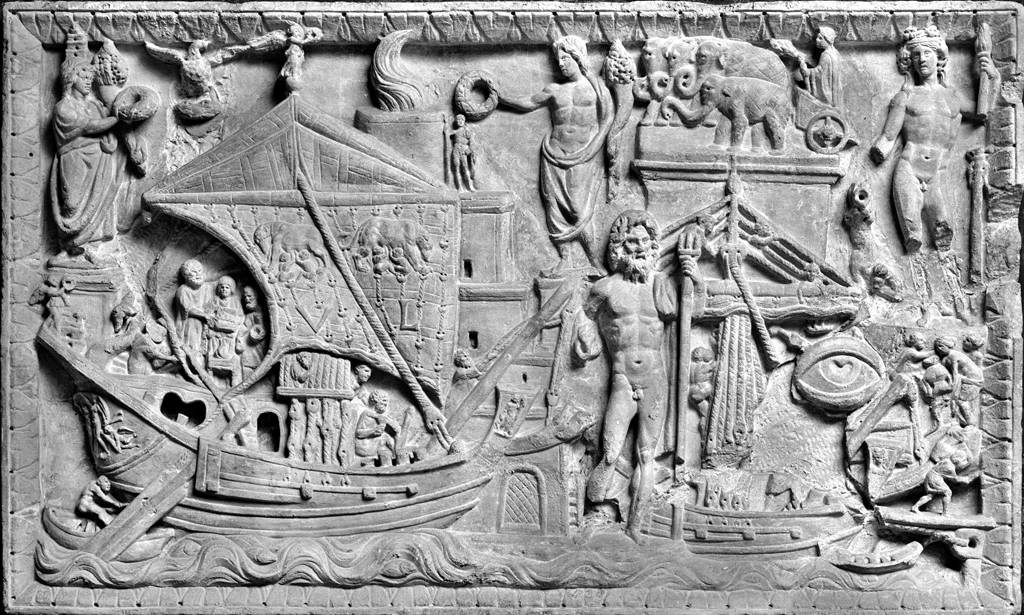
Fig. 3. Ships in the harbour of Ostia. Relief in the Torlonia Museum, Rome, ca. 200 A.D.
Once the goods were loaded the lenunculus could sail to the harbour and the shore where everything could be stored in warehouses, or they could sail immediately to Rome.
We have already mentioned that the journey to Rome was difficult due to the many bends and the strong crosscurrent. Sailing was, in these circumstances, no option and rowing against the current was possible, but time consuming and laborious. For these reasons, ships were towed by bullocks or by man power. To tow a ship properly it was necessary that the mast was placed in the forecastle. Ropes were attached to the mast and from the towpath on the shore the ship could be towed up the river. The exact location of the mast was very important for the stability of the ship.
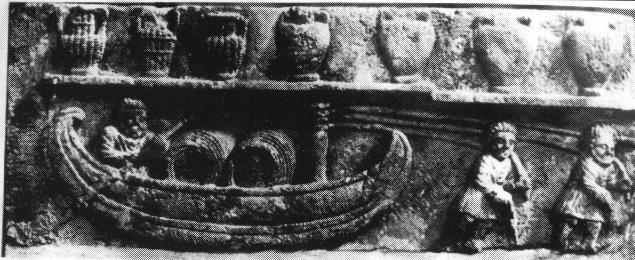
Fig. 4. A ship is towed up.
Relief in Avignon (France).
But there was also an alternative. On the aft of the lenunculus we clearly recognize a winch, distinguishable by the four spokes. Although this device doesn't appear frequently in representations of ships - certainly never with this kind of detail - we know from written documentation that the winch was part of the standard equipment of a ship. A papyrus with a leasing contract of a ship, dated to 212 A.D., mentions a complete equipment:[12] the ship was leased along with "mast, yard, linen sail, ropes ... landing plank, winch ... ropes of palm fibre, tow rope, mooring lines, ... ." It is very important that the different kinds of rope are named separately. The first set of ropes is obviously connected with the sails. After the 'winch' three different kinds of rope are mentioned. It is clear what is meant by 'mooring lines'. The tow rope is in this case the rope that was used to tow-up the ship with manpower. And then, there is a third set of ropes (plural) of which the function is not given. Further investigation of ship iconography reveals more examples, albeit less obvious, of winches. On the aft part of the ship on the right side of the mosaic of statio 46 of the Piazzale we see something that can be interpreted as a winch, without the spokes.[13]
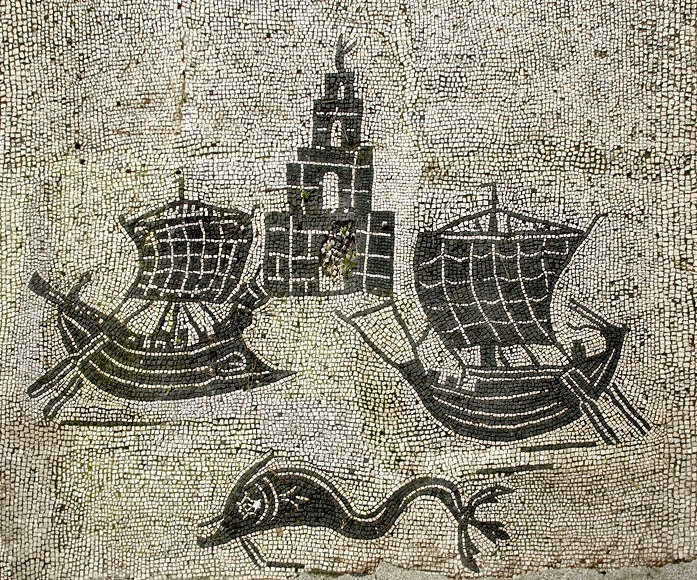
Fig. 5. Mosaic of statio 46.
On the aft part of the ship on the right we can see something that can be interpreted as a winch.
Another possible example of a winch can be seen on a reused relief in the cathedral of Salerno. On this relief a similar ship is depicted by the quay. Saccarii are unloading the ship. The ship lies at anchor and the mast is lowered as was normally done in this situation. On the stern we see the helmsman. In front of him, practically on the wale, there is clearly a winch, also minus its spokes.
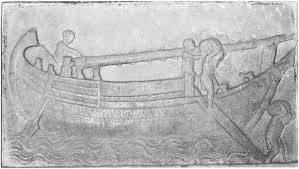
Fig. 6. Reused relief in the cathedral of Salerno.
Casson declares that the winch was used in the first place to lower and lift the anchor.[14] But on the relief of Salerno there is no trace of an anchor rope attached at the winch. The winch is there without further equipment.
A solution can be found in a text of the Larousse encyclopaedia.[15] Although this text is from the 19th century we may assume that the Romans thought about the mechanism in a similar way. This is how it worked. On the ship was a winch on which two ropes (cf. the plural in the leasing contract) were wound. One rope clockwise, the other counter clockwise. On regular distances on the towpath fixed points to which the ropes could be tied were installed. On the first point the clockwise rope was fastened and while turning the winch counter-clockwise this rope was coiled up around the winch and the other rope - the counter-clockwise one - was unrolled. When the first rope was completely rolled and the second completely unrolled a man on the towpath took the second rope and tied it to the following fixed point. The second rope could be coiled up again in the same continuous turning movement. Working like this, the ship didn't lose speed and could reach Rome practically on its own. The plural in this explanation is decisive. If only one rope had been used it would have been necessary to unroll it again every time after it was coiled up by the winch, throw it to the towpath and tie it again on one of the fixed points. This would have been a time-consuming operation during which the ship could be driven back by the strong current.
Returning to the scene in Statio 25, we may draw even further conclusions. We may assume that it was the task of the lenunculus to take goods (even in the open sea) from arriving merchantmen and to organise the further transport to Rome. The mosaic thus gave a clear message to passers-by that lenunculi were able to bring all these wares directly to Rome ... without middlemen.
Bibliography
Casson L., Ships and seamanship in the ancient World, Baltimore, 1971.
Finley M.I., The ancient Economy, Updated edition, Los Angeles - London, 1999.
Friedman Z., Ship Iconography in Mosaics. An aid to understanding ancient ships and their construction, = BAR International Series 2202, 2011.
Hunt A., Edgar c., Select papyri (Loeb Classical Library 1932-1934).
Meiggs R., Roman Ostia, Oxford, 1973.
Mitteis L., Wilcken U., Grundzüge und Chrestomathie der Papyruskunde, Band 1, Leipzig - Berlin, 1912.
Smith W., Dictionary of Greek and Roman Antiquities, London, 1870.
Notes
[1] Cf. Finley, pp. 198-199.
[2] Dion.Hal. III,44. English translation from http://penelope.uchicago.edu/Thayer/E/Roman/Texts/Dionysius_of_Halicarnassus/3C*.html.
[3] Dionysius mentions only '3000' without reference to any measure of capacity. From a passage in Cassius Dio (LVI, 27, 3) we learn that the measure for ships was probably the amphora.
[4] Strabo V, 3. English translation from http://penelope.uchicago.edu/Thayer/E/Roman/Texts/Strabo/5C*.html.
[5] Tac.Ann. XV, 18, 3.
[6] W.Chrest. 445.
[7] Smith, Dictionary, 1870, pp. 90-91.
[8] Friedman, pp. 110-111.
[9] Casson, p. 70.
[10] Friedman, p. 110.
[11] Casson, pp. 201-213.
[12] Select Papyri, nr. 38.
[13] Friedman, p. 118.
[14] Casson, pp. 245-258.
[15] Larousse, Grand dictionnaire universel du XIX siècle, s.v. halage: "Le halage à points fixes s'opère en faisant mouvoir des treuils au moyen de machines places sur le bateau, de manière à enrouler une corde attachée à un point fixe. On peut avoir des points fixes établis d'espace en espace et qui forment tant de stations; mais cela exige que, pendant que le bateau parcourt une station, la corde destinée à faire parcourir la station suivante soit portée en avant et déroulée."